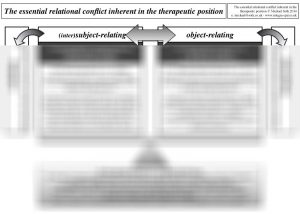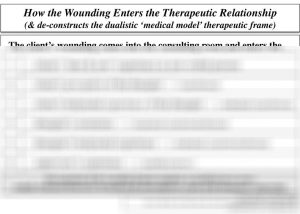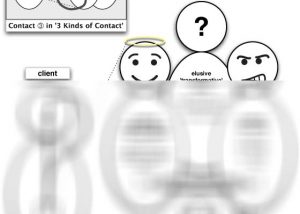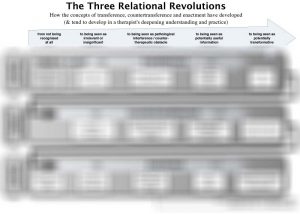This handout is a more detailed description of Contact 3 in the '3 Kinds of Contact' - it describes the 4 objects which are all constellated in the countertransference experience during an enactment - the therapist can experience all of them in [...]

The Essential Relational Conflict Inherent in the Therapeutic Position: Object- versus Subject-Relating (2014)
Michael - Handouts2018-02-21T01:25:31+00:00This handout crystallises the essential tension inherent in the therapeutic position, between: 'I-it' object-relating (which can be both deeply healing and deeply wounding) on the one hand, and dialogical 'I-I' subject-relating (which can be both deeply healing and deeply wounding) on the other. The implication is that either [...]
The Three Relational Revolutions (2007)
Michael - Handouts2017-04-07T03:02:24+00:00This handout summarises what I conceive of as the three relational revolutions that have occurred over the last 100 years in psychotherapy. The first was Freud's reframing of the transference from an obstacle to the treatment into the 'royal road' into the depths of the process - this [...]

How the Wound Enters the Therapeutic Relationship (2005)
Michael - Handouts2017-04-07T03:01:47+00:00This table is a summary of the 6-and-a-half steps by which we can conceive of the late 19th century medical model frame of therapy having been deconstructed and broken down over the last 100 years. It is a summary of an article published in 'Therapy Today' under the [...]
Three Kinds of Contact (1995)
Michael - Handouts2017-04-07T02:57:20+00:00This handout is one of the most basic and fundamental to a relational perspective on therapy. If it is indeed 'the relationship that matters', what kinds of contacts can exist between client and therapist? Alongside the different modalities of therapeutic relatedness, we can recognise the coming and going [...]
Three Kinds of Contact (1995, simple)
Michael - Handouts2017-04-07T02:57:13+00:00This handout is one of the most basic and fundamental to a relational perspective on therapy. If it is indeed 'the relationship that matters', what kinds of contacts can exist between client and therapist? Alongside the different modalities of therapeutic relatedness, we can recognise the coming and going [...]




